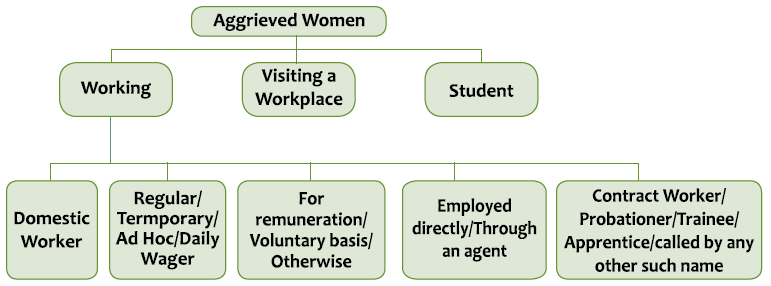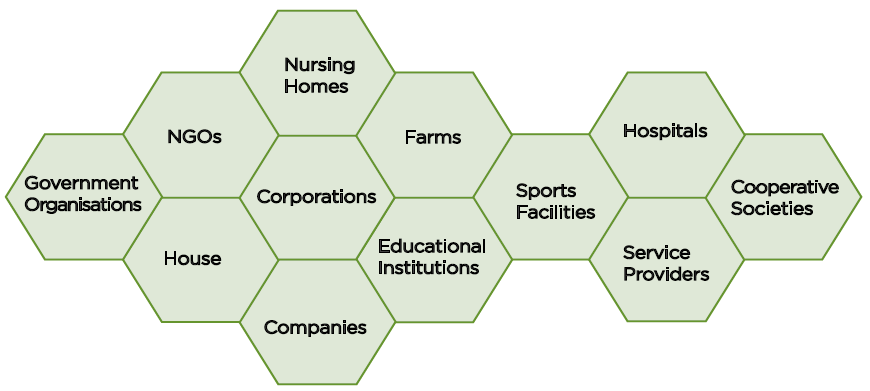Workplace Sexual Harassment
Workplace Sexual Harassment
The Sexual Harassment of Women at Workplace (Prevention, Prohibition and Redressal) Act 2013 addresses the issue of workplace sexual harassment faced by women.
Women covered under the Act
- The Act recognizes the right of every woman to a safe and secure workplace environment irrespective of her age or employment/work status. Hence, the right of all women working or visiting any workplace whether in the capacity of regular, temporary, adhoc, or daily wages basis is protected under the Act.
- It includes all women whether engaged directly or through an agent including a contractor, with or without the knowledge of the principal employer.They may be working for remuneration, on a voluntary basis or otherwise.
- Their terms of employment can be express or implied.
- Further, she could be a co-worker, a contract worker, probationer, trainee, apprentice, or called by any other such name.
- The Act also covers a woman, who is working in a dwelling place or house.

Definition of Workplace
- A workplace is defined as “any place visited by the employee arising out of or during the course of employment, including transportation provided by the employer for undertaking such a journey.”
- As per this definition, a workplace covers both the organised and un-organised sectors.
- It also includes all workplaces whether owned by Indian or foreign company having a place of work in India.
As per the Act, workplace includes:
- Government organizations, including Government company, corporations and cooperative societies;
- Private sector organisations, venture, society, trust, NGO or service providers etc. providing services which are commercial, vocational, educational, sports, professional, entertainment, industrial, health related or financial activities, including production, supply, sale, distribution or service;
- Hospitals/Nursing Homes;
- Sports Institutes/Facilities;
- Places visited by the employee (including while on travel) including transportation provided by employer;
- A dwelling place or house.
The Act defines the Unorganised Sector as:
- Any enterprise owned by an individual or self-employed workers engaged in the production or sale of goods or providing services of any kind;
- Any enterprise which employs less than 10 workers.

Sexual harassment at the workplace
“Sexual Harassment” includes anyone or more of the following unwelcome acts or behaviour ( whether directly or by implication), namely :
- Physical contact or advances;
- A demand or request for sexual favours;
- Making sexually coloured remarks;
- Showing pornography;
- Any other unwelcome physical, verbal or non-verbal conduct of a sexual nature

Key elements of workplace sexual harassment
- Very often situations that start off innocently end up in inappropriate and unprofessional behaviours.
- It is important to remember that workplace sexual harassment is sexual, unwelcome and the experience is subjective.
- It is the impact and not the intent that matters and it almost always occurs in a matrix of power.
- It is possible that a woman may experience a single instance of sexual harassment or a series of incidents over a period of time.
- It is important also to remember that each case is unique and should be examined in its own context and according to the surrounding circumstances as a whole.
- To enable prevention of sexual harassment at the workplace, it is critical to recognize and differentiate between welcome and unwelcome sexual behaviour.
- Listed are some examples of how “unwelcome” and “welcome” behaviour is experienced
| UNWELCOME | WELCOME |
|---|---|
| Feels bad | Feels good |
| One-sided | Reciprocal |
| Feels powerless | In-control |
| Power-based | Equality |
| Unwanted | Wanted |
| Illegal | Legal |
| Invading | Open |
| Demeaning | Appreciative |
| Causes anger/sadness | Happy |
| Causes negative self-esteem | Positive self-esteem |
Impact of inappropriate behaviour
The impact of sexual harassment at the workplace is far-reaching and is an injury to the equal right of women. Not only does it impact her, it has a direct bearing on the workplace productivity as well as the development of the society. Below is a list of select examples of such negative impacts.

| Professional | Personal |
|---|---|
|
|
Sexual Harassment is a subjective experience
In 2010, the High Court of Delhi endorsed the view that sexual harassment is a subjective experience and for that reason held "We therefore prefer to analyze harassment from the (complainant’s) perspective. A complete understanding of the (complainant’s) view requires.... an analysis of the different perspectives of men and women. Conduct that many men consider unobjectionable may offend many women.... Men tend to view some forms of sexual harassment as "harmless social interactions to which only overly-sensitive women would object". The characteristically male view depicts sexual harassment as comparatively harmless amusement.... Men, who are rarely victims of sexual assault, may view sexual conduct in a vacuum without a full appreciation of the social setting or the underlying threat of violence that a woman may perceive.”
Dr. Punita K. Sodhi v. Union of India & Ors. W.P. (C) 367/2009 & CMS 828, 11426/2009 On 9 September, 2010, in the High Court of Delhi
Examples of behaviours and scenarios that constitue sexual harassment
Below are examples of behaviour that may or may not constitute workplace sexual harassment in isolation. At the same time, it is important to remember that more often than not, such behaviour occurs in cluster. Distinguishing between these different possibilities is not an easy task and requires essential training and skill building.

Some examples of behaviour that constitute sexual harassment at the workplace:
- Making sexually suggestive remarks or innuendos.
- Serious or repeated offensive remarks, such as teasing related to a person’s body or appearance.
- Offensive comments or jokes.
- Inappropriate questions, suggestions or remarks about a person’s sex life.
- Displaying sexist or other offensive pictures, posters, mms, sms, whatsapp, or e-mails.
- Intimidation, threats, blackmail around sexual favours.
- Threats, intimidation or retaliation against an employee who speaks up about unwelcome behaviour with sexual overtones.
- Unwelcome social invitations, with sexual overtones commonly understood as flirting.
- Unwelcome sexual advances which may or may not be accompanied by promises or threats, explicit or implicit.
- Physical contact such as touching or pinching.
- Caressing, kissing or fondling someone against her will (could be considered assault).
- Invasion of personal space (getting too close for no reason, brushing against or cornering someone).
- Persistently asking someone out, despite being turned down.
- Stalking an individual.
- Abuse of authority or power to threaten a person’s job or undermine her performance against sexual favours.
- Falsely accusing and undermining a person behind closed doors for sexual favours.
- Controlling a person’s reputation by rumour-mongering about her private life.

Some examples of behaviour that may indicate underlying workplace sexual harassment and merit inquiry:
- Criticizing, insulting, blaming, reprimanding or condemning an employee in public.
- Exclusion from group activities or assignments without a valid reason.
- Statements damaging a person’s reputation or career.
- Removing areas of responsibility, unjustifiably.
- Inappropriately giving too little or too much work.
- Constantly overruling authority without just cause.
- Unjustifiably monitoring everything that is done.
- Blaming an individual constantly for errors without just cause.
- Repeatedly singling out an employee by assigning her with demeaning and belittling jobs that are not part of her regular duties.
- Insults or humiliations, repeated attempts to exclude or isolate a person.
- Systematically interfering with normal work conditions, sabotaging places or instruments of work.
- Humiliating a person in front of colleagues, engaging in smear campaigns.
- Arbitrarily taking disciplinary action against an employee.
- Controlling the person by withholding resources (time, budget, autonomy, and training) necessary to succeed.
Some examples of workplace behaviours that may not constitute sexual harassment:
- Following-up on work absences.
- Requiring performance to job standards.
- The normal exercise of management rights.
- Work-related stress e.g. meeting deadlines or quality standards.
- Conditions of works.
- Constructive feedback about the work mistake and not the person.
Forms of workplace sexual harassment
Generally workplace sexual harassment refers to two common forms of inappropriate behaviour:
- Quid Pro Quo (literally ‘this for that’)
- Implied or explicit promise of preferential/detrimental treatment in employment
- Implied or express threat about her present or future employment status
- Hostile Work Environment
- Creating a hostile, intimidating or an offensive work environment
- Humiliating treatment likely to affect her health or safety
Source : Handbook on Sexual Harassment of Women at Workplace
Last Modified : 5/24/2024
This topic provides information about mandate and ...
This topic provides information about Global Norm...
This topic covers the information related to Sexua...
This topic covers the Information related to Rape
